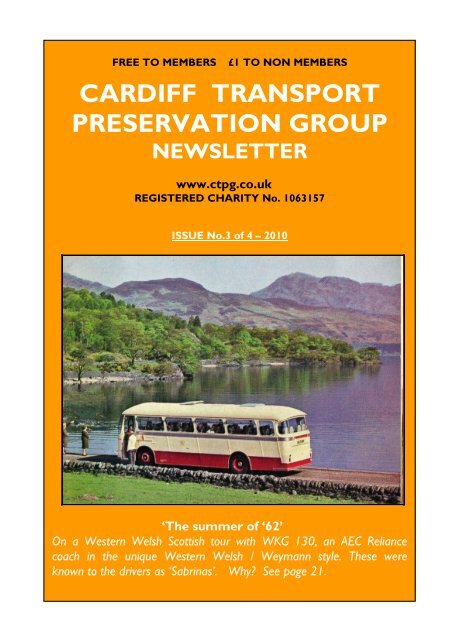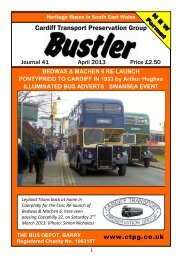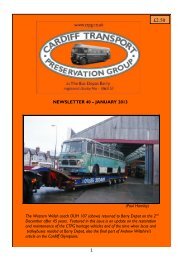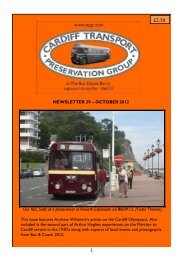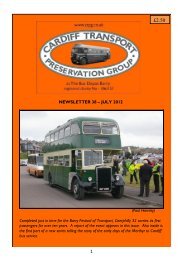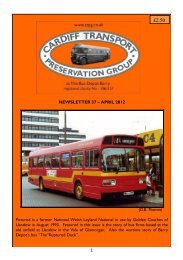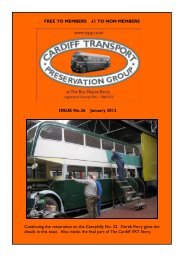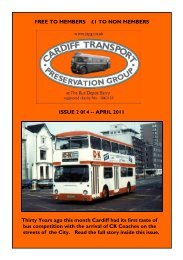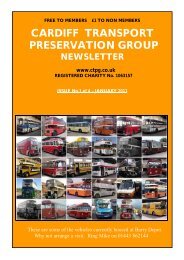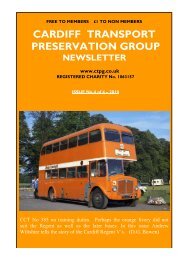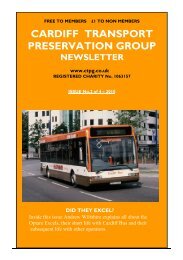Create successful ePaper yourself
Turn your PDF publications into a flip-book with our unique Google optimized e-Paper software.
FREE TO MEMBERS<br />
£1 TO NON MEMBERS<br />
CARDIFF TRANSPORT<br />
PRESERVATION GROUP<br />
NEWSLETTER<br />
www.ctpg.co.uk<br />
REGISTERED CHARITY No. 1063157<br />
ISSUE No.3 <strong>of</strong> 4 <strong>–</strong> <strong>2010</strong><br />
‘The summer <strong>of</strong> ‘62’<br />
On a Western Welsh Scottish tour with WKG 130, an AEC Reliance<br />
coach in the unique Western Welsh / Weymann style. These were<br />
known to the drivers as ‘Sabrinas’. Why? See page 21.<br />
1 1<br />
1
At the Barry Festival the former Barry based Bristol VR returned home, now owned by group<br />
members. The group AEC Swift is nearing completion and at its new home at Barry.<br />
Our Chairman gives Vale A.M. Jane Hutt a tour <strong>of</strong> the showground. (CTPG / J.Hutt)<br />
2
CHAIRMAN’S MESSAGE:<br />
It seems that a lot happens between our second and third newsletter<br />
each year! Three months ago the Barry rally had just finished and three<br />
days ago Bus & Coach Wales took over the college car park in Merthyr.<br />
Both rallies were well attended by exhibitors and visitors. I think most<br />
people enjoyed themselves. We received some good publicity prior<br />
to both events which does always help. I would like to thank<br />
everyone that helped me with both events either before or during the<br />
rallies, a lot <strong>of</strong> preparation goes into the organisation and also making<br />
sure our depot and buses run and look good <strong>–</strong> where were the 100<br />
members that did not help or assist??<br />
Having just completed our four road runs with a nice mix <strong>of</strong> old and new<br />
buses and different destinations <strong>–</strong> I need some ideas for next year both<br />
buses and routes.<br />
Our active fleet has grown this year with eight buses available to us.<br />
A firm favourite in PAX 466F has come to us, this important<br />
historic bus is in fine condition and has been used on a number <strong>of</strong> rallies,<br />
as its owner decreed. It has fine hill climbing ability with a Leyland 680 in<br />
the front it is audibly different to Caerphilly 32 which still retains a 600.<br />
Another important addition to the MOTed vehicles (and not before time)<br />
is our AEC Swift MBO 512F which has returned from Brent Thomas in<br />
running order. A lot <strong>of</strong> work has been done on this bus so we are taking<br />
it carefully and getting to know it before going any distance with it.<br />
We had also been donated Cardiff 348 and 510, the Bristol VRT and<br />
Olympian. During August we also moved Cardiff 587 and Western<br />
Welsh 678 from Hereford to the docks yard and depot respectively,<br />
thereby completing the move <strong>of</strong> the entire CTPG fleet to the Barry area<br />
(other than WW 856 which is still in Scotland.)<br />
There is as always a lot to do at the Depot so please come along and<br />
help out, it is not just the buses that need regular maintenance.<br />
I would like to give members Alan Poole and Cliff Parker our best wishes,<br />
both have been in hospital recently.<br />
Mike; Tel: 01443 862144 Email :mikeystrad73@btinternet.com<br />
Also keep up to date on our Website and Facebook page<br />
3
BARRY FESTIVAL <strong>of</strong> TRANSPORT; (by Paul Gilbertson)<br />
The weather for the sixth successive year proved to be tailor made for<br />
this event, copious amounts <strong>of</strong> sunshine laced with cooling breezes. The<br />
event was staged at two sites namely the former Western Welsh bus<br />
depot in Broad Street and Hood Road which until the late 1960s was a<br />
rail freight depot for Barry and also used for storage <strong>of</strong> some <strong>of</strong> the<br />
famed Woodham Bros. condemned locomotives. The two sites were<br />
linked by a free service <strong>of</strong> historic buses and coaches manned by owners<br />
and volunteers.<br />
From early morning buses, coaches, commercial and military vehicles,<br />
cars and motor cycles descended on Barry, many from far away places<br />
such as Kent, Bristol, Gloucester, Swindon and Plymouth. Two highlights<br />
<strong>of</strong> the day as far as buses were concerned was the return <strong>of</strong> ex Cardiff<br />
AEC Swift MBO 512F <strong>of</strong> which restoration is nearing completion and the<br />
return <strong>of</strong> VHB 678S, the former National Welsh Bristol open top VRT,<br />
from Scotland having been far since its days <strong>of</strong> operating in the Barry area<br />
namely North Wales, & Essex. The latter was joined by open toppers<br />
from the Swansea area, namely Bristols WNO 484, SWN 159 and RTH<br />
931S. Combined with our own Guy meant we had five open toppers on<br />
parade. Other significant newcomers this year were a trio <strong>of</strong><br />
Routemasters, the ex. Southdown ‘Queen Mary’ PD3 BUF 278C and the<br />
Burnley, Colne & Nelson Tiger Cub PCW 957.<br />
Various historic vehicles were used throughout the day to convey rally<br />
visitors to parts <strong>of</strong> Barry and the Vale <strong>of</strong> Glamorgan and it was a first for<br />
many to ride on an open topper.<br />
The Broad Street bus depot was utilised to display static vehicles in<br />
various stages <strong>of</strong> restoration as well as selling the usual items such as<br />
model buses, bus photographs and books, and refreshments. As always<br />
our Brinkworth room museum was very popular. The CTPG were<br />
pleased to welcome the visit <strong>of</strong> the Vale Mayor & Mayoress and once<br />
again we had the support <strong>of</strong> our local Assembly Member, Jane Hutt.<br />
To achieve such a memorable and successful day thanks due to the<br />
organiser our Chairman Mike Taylor and all the other volunteers who<br />
gave freely <strong>of</strong> their time to make such an event possible and without this,<br />
transport as we remember it would be just a fading and distant memory.<br />
4
WENSLEYDALE WANDERINGS <strong>–</strong> 2 by Berwyn Prys Jones<br />
Berwyn recalls his visit to Cumbria in the spring <strong>of</strong> 2009 …………..<br />
As a small mechanical problem brought an abrupt end to my holiday to<br />
the north <strong>of</strong> England and Scotland last year, I decided I’d give it a second<br />
try earlier this year. The North Yorkshire Moors Railway late spring gala<br />
seemed to be a logical starting point with the visit <strong>of</strong> ‘Tornado’ a part <strong>of</strong><br />
the attraction, so I arrived fairly early one Friday morning at Grosmont<br />
only to find my way barred by the level crossing gates. ‘Tornado’ with its<br />
teak coach attached was about to reverse on to its train.<br />
For such a new engine, it seemed remarkably dirty. It had probably been<br />
at work all week following the unfortunate discovery <strong>of</strong> a wrongly-cast<br />
(British-made) fusible plug on the previous Sunday. Even the following<br />
day, little effort had been made to clean it up for its clamouring public.<br />
And considering the amount <strong>of</strong> effort and expense that had gone into<br />
building it, I was rather surprised towards the end <strong>of</strong> the second day to<br />
hear a bored voice in my carriage remark ‘Oh, it’s Tornado again ...’.<br />
Some people get fed up very easily! Even so, it took us up to Goathland<br />
with no trouble at all and the trains it and ‘Sir Nigel Gresley’ hauled<br />
appeared to be packed. I soon learned that the trains with less glamorous<br />
engines at the front end had much more room in them.<br />
On the Sunday, I paid a visit to the South Yorkshire Transport Museum, a<br />
building rather hidden away at the far end <strong>of</strong> an industrial estate. Visitors<br />
appeared to be few for an open day but there was one bus running, the<br />
ex-Doncaster Leyland PD2/40 with an ex-trolleybus Roe body. As I’d<br />
travelled on it at a Sandt<strong>of</strong>t Open Day a couple <strong>of</strong> years previously, I had<br />
a look around the ex-Yorkshire Woollen District Leyland Tiger<br />
PS1/Weymann (HD 7905) and the ex-Western National Bristol Lodekka<br />
(VDV 760) parked outside, and then ventured in.<br />
The depot contained a number <strong>of</strong> buses in various states <strong>of</strong> preservation.<br />
The most striking that day was a Duple-bodied Leyland Comet ECPO/1R<br />
(MHY 765), minus engine and bonnet but newly painted light blue. As so<br />
<strong>of</strong>ten happens in such museums, the buses were packed so close together<br />
that it was difficult to photograph or film, or even appreciate, them<br />
properly <strong>–</strong> a point that should be borne in mind, perhaps, on Barry depot<br />
5
open days. One more modern double-decker had been refurbished to<br />
house a collection <strong>of</strong> exhibits such as uniforms and model buses.<br />
Later that day, a return visit to the Wensleydale Railway led on to a trip<br />
along Swaledale. If you haven’t seen the Julia Bradbury programme <strong>of</strong><br />
Wainwright’s Coast to Coast Walk, you may not be familiar with this,<br />
one <strong>of</strong> the finest Yorkshire dales. The road through it comes close to my<br />
favourite <strong>–</strong> the Mid Wales one from Abergwesyn to Tregaron.<br />
Former Alexander Tiger CWG 286 at Kirkby Stephen<br />
An overnight stay in Kirkby Stephen brought me to the village <strong>of</strong><br />
Ravenstonedale early enough to reach Cumbria Classic Coaches’ bus<br />
depot (aka a large shed housing half a dozen elderly buses) at Bowber<br />
Head. Outside, about to start <strong>of</strong>f, was CWG286, the Alexander C35Fbodied<br />
former W. Alexander & Sons Leyland Tiger PS1/1.<br />
Getting out <strong>of</strong> the car, the first person I saw was Gordon, the cheery<br />
conductor whose company I had enjoyed so much last year. It was good<br />
to see him again. We bumped and bounced along the road from Bowber<br />
Head towards the main road and a little while later turned <strong>of</strong>f at the<br />
6
Lamb and Flag Inn where we spent a couple <strong>of</strong> minutes parked alongside<br />
a brand spanking new 09-registered ultra-luxurious Setra ‘Grand Tourer’<br />
<strong>of</strong> Shearings. I’m sorry now that I didn’t get <strong>of</strong>f and photograph the two<br />
together. The contrast between them must have been almost laughable,<br />
yet the passengers on our bus seemed to be quite happy to stay aboard<br />
our 59-year old conveyance!<br />
Our driver was a lady <strong>–</strong> Alison. There being no glass between her<br />
compartment and the front end <strong>of</strong> the bus, both she and Gordon were<br />
able to greet the local passengers and the visitors coming aboard. I<br />
wondered whether she found the controls and the clutch in particular,<br />
heavy, but when I asked her about this later she said no: it was quite light<br />
compared to that on the Lodekka ‘which tends to fight against you’. No<br />
jokes about lady drivers, please. Alison drove just as competently as the<br />
other drivers. Soon we were <strong>of</strong>f down the road to Kirkby Stephen and<br />
turning into the yard <strong>of</strong> the Kirkby Stephen station on the Settle &<br />
Carlisle railway line. The train was a little late arriving but a couple had<br />
let the Cumbria Classic Coaches people know that they wanted to<br />
transfer from train to bus and this they duly did. Integrated transport<br />
rules in the high fells!<br />
Part <strong>of</strong> the road to Hawes parallels the S&C for a couple <strong>of</strong> miles or so<br />
and the views are well worth enjoying. There’s comparatively little traffic<br />
so that the leisurely speed <strong>of</strong> the Tiger meant that we didn’t cause any<br />
unnecessary hold-ups for following traffic. Arrival at Hawes brought us<br />
into this busy little town <strong>–</strong> it was market day <strong>–</strong> and the looks on people’s<br />
faces were a joy to behold: from total indifference to amazement and<br />
smiles <strong>of</strong> nostalgic pleasure.<br />
Parked in the station yard was what I’d hoped to see: LHN 823, the red<br />
Bristol L/ECW B35R that brought back memories <strong>of</strong> seeing the last <strong>of</strong> the<br />
United Welsh single-deckers at work. Last year, we’d had the MW, but<br />
now we were heading even further back in time. The journey to Redmire<br />
and back and then on to Garsdale station was even better than last year’s<br />
given the bus’ characteristic sound, and the volume <strong>of</strong> traffic through the<br />
narrow streets <strong>of</strong> Hawes meant that we arrived at Garsdale just a few<br />
seconds before the train appeared. Swiss timekeeping on a Bristol L!<br />
On our return to Hawes, I found that the MW had been parked away at<br />
the far end <strong>of</strong> the car park and a little while later a heavily loaded convoy<br />
7
<strong>of</strong> L and MW left on their return journey to Ripon. The preserved buses<br />
we saw that day seemed to be carrying more passengers than the local<br />
service buses ...<br />
A little later, we returned to Ravenstonedale and Bowber Head via<br />
Kirkby Stephen. Even a whole day’s journeying, though, couldn’t prevent<br />
my looking forward to yet another day on Cumbria Classic Coaches’<br />
preserved vehicles. Last year, they’d introduced another route <strong>–</strong> to<br />
Barnard Castle— and were running it again this year, so it was too good<br />
an opportunity to miss.<br />
The following morning, outside the depot at Bowber Head, stood ex-<br />
Crosville DLB 978 (627 HFM), the convertible open-topper with its top<br />
firmly fixed on <strong>–</strong> it was pretty windy that day. With Gordon again as our<br />
conductor, but with the ‘boss’ himself, Will Hamer, at the wheel, we<br />
bumped and bounced along the road from Bowber Head towards the<br />
main road once more and having called in at Kirkby Stephen station and<br />
the town itself, headed <strong>of</strong>f to Middleton-on-Tees. I’d never been along<br />
that road before and the views from the top deck were stunning. We<br />
were very fortunate: the previous week it had been raining hard.<br />
I’d noticed that the Lodekka (or ‘Harvey’, as it’s known to the company)<br />
seemed to climb the hills with rather more zest than I’d remembered<br />
from my own days as a Crosville passenger, so when we stopped in<br />
Middleton-on-Tees I asked Will about this. He told me that the bus had<br />
been re-engined with a Gardner unit but that it had itself been replaced<br />
with a bigger (10.75 litre) one. No wonder it didn’t trundle along the flat<br />
and slow to crawling pace on hills!<br />
When I suddenly remembered that I’d hadn’t seen the company’s latest<br />
acquisition, the ex-Bamber Bridge AEC Regent III, I asked about it and<br />
learnt that it had gone to Brough for testing.<br />
(A good reason to return again soon!)<br />
Following a leisurely walk around the pleasant small town <strong>of</strong> Middletonon-Tees,<br />
we got back on board for the journey down the valley to<br />
Barnard Castle. I’d visited the place some years ago having seen a<br />
television programme on the Bowes Museum, a French château built in<br />
Teeside by a rich husband and wife who’d been avid collectors <strong>of</strong> art and<br />
china, including a famous automaton <strong>of</strong> a swan. I’d have liked to<br />
photograph the Lodekka posed in front <strong>of</strong> the château but unfortunately<br />
8
there was scaffolding around one wing. At two o’clock almost all the<br />
visitors to the building gathered round the mechanical swan to see it<br />
doing its famous 34-second routine <strong>of</strong> swivelling its neck before diving<br />
into the ‘water’ to extract a fish. The whole audience clapped in delight.<br />
Former Crosville convertible open topper ‘Harvey’ ready to leave Bowber Head<br />
A walk back into the town and a wander round brought me to the<br />
Morrisons’ car park, where our Lodekka was laying over. Our journey<br />
back to Kirkby Stephen was something <strong>of</strong> a shortcut but none the worse<br />
for that as it took us along the dual carriageway A66 to Brough and then<br />
back to Kirkby Stephen. Before returning to the depot, we learnt that we<br />
had to stop to pick up fuel.<br />
Gordon went through his usual routine <strong>of</strong> asking if there were any<br />
questions. ‘No? Good! I won’t have to think <strong>of</strong> the answers!”<br />
We passed a filling station with headroom <strong>of</strong> about 12’ 6”. Had the ro<strong>of</strong><br />
been <strong>of</strong>f, we might have been able to stop there at the minor cost <strong>of</strong><br />
several passengers being decapitated, but we went instead to one a little<br />
further on where the headroom was over 14’. Even on returning to<br />
Ravenstonedale and the bouncy road up to Bowber Head, I was sorry<br />
9
that the journey had to end. Once again, it had been great fun <strong>–</strong> and the<br />
rest <strong>of</strong> the passengers seemed to have enjoyed the experience just as<br />
much as I had. Thanks again to Cumbria Classic Coaches and their staff it<br />
had been an excellent and highly recommended day out.<br />
(All photographs by Berwyn Prys Jones)<br />
--------------------------------------<br />
JUNE EVENING RUN;<br />
On 16 th June the 1964 Guy Arab open topper was fired up by Ian Barlow<br />
for our evening run. On a very warm evening we made for Llandaff and<br />
the BBC Studios. Our group <strong>of</strong> about 20 were treated to a tour <strong>of</strong> the<br />
BBC complex, our guides showing us the various television studios, some<br />
<strong>of</strong> which were surprisingly small. Certain members <strong>of</strong> the group took the<br />
opportunity to sit in the newsreader’s chair and on the famous red s<strong>of</strong>a<br />
used for interviews. Outside the building we were shown the façade <strong>of</strong><br />
shop fronts used in the Welsh language soap ‘Pobol Y Cwm’.<br />
The operations suites held a confusing array <strong>of</strong> monitors and buttons that<br />
eventually bring the TV programmes to our screens. The two hour tour<br />
prompted one to think beyond the flat screen that we look at every day.<br />
Your editor is now convinced that there are no longer lots <strong>of</strong> little<br />
people inside his TV set !<br />
Many thanks to our guides, the organisers Mike and our own BBC man,<br />
Paul Burgess. The warm evening continued with a final run through<br />
Whitchurch where our bus was the subject <strong>of</strong> many an odd glance from<br />
those enjoying a drink after the World cup match.<br />
JULY EVENING RUN;<br />
On 21 st July the rain soon eased to bring a pleasant evening. For our July<br />
trip we used PAX 466F, the immaculate former Bedwas & Machen<br />
Leyland PD3/4 which is on long term loan from Julian Peddle. This<br />
historically important bus was the last lowbridge built in the U.K. and the<br />
last exposed radiator Leyland to be supplied to a Welsh operator.<br />
The object <strong>of</strong> the evening was to visit the garage at Bedwas which is soon<br />
to be demolished. Attempts were made to position the bus to recreate<br />
two photographs taken 36 years ago shortly before the small Bedwas<br />
UDC fleet was swallowed up by Rhymney Valley District Council.<br />
10
Those who wished could visit the adjacent club to enjoy a pint. Our<br />
drivers for the evening were Kevin (Gerbil) Edwards and Paul (Tiger<br />
Cub) Burgess. The return run was via Caerphilly Mountain including an<br />
impressive hill start at Watford Chapel where the 680 engine showed its<br />
power. The original 600 engine had been replaced in the 1980’s.<br />
(See the montage on page 23.)<br />
AUGUST EVENING RUN;<br />
Around 30 members and guests met at County Hall on 18 th August for<br />
the last road run <strong>of</strong> <strong>2010</strong>. This time the vehicle was from the Bristol<br />
Omnibus Vehicle Collection which once again Dr Mike Walker drove<br />
over from Somerset. The bus was 969 EHW, a Bristol LD6G Lodekka<br />
with 58 seat ECW bodywork which was new to Bath Services in 1959.<br />
This bus was later used as a staff bus at Bristol Aerospace at Filton before<br />
being bought for preservation by Ge<strong>of</strong>f Green. Some years later the<br />
restoration was completed by Thamesdown Transport at Swindon for<br />
the present owners.<br />
We travelled through the Vale <strong>of</strong> Glamorgan via Barry and Llantwit Major<br />
in a rainstorm and made for the A48 and Cowbridge. A refreshment<br />
stop was made at The Red Lion, Bonvilston. The little bar had seldom<br />
been so busy. The driving for the evening was shared between Nicky<br />
Reason and Mike Walker. Thanks were given to Mike and we hope he<br />
will be able to visit again in 2011.<br />
NANTGARW VISIT:<br />
Also in August, at short notice, the Chairman organised a visit for the<br />
original members <strong>of</strong> the 46 Group plus a few friends to the National<br />
Museum <strong>of</strong> Wales storage facility at Parc Nantgarw. This site, not<br />
normally open to the public, is the resting place <strong>of</strong> much <strong>of</strong> the heavy<br />
machinery and vehicles formally housed at the late, lamented Bute Street<br />
Welsh Industrial & Maritime Museum. Naturally <strong>of</strong> particular interest to<br />
the group were Cardiff Crossley 46 and Cardiff Trolley 215 as well as the<br />
sagging Gelligaer Regal. Also viewed were railway and marine exhibits as<br />
well as other road vehicles including the Treforest made Bown<br />
motorcycles and Gilbern cars made at Llantwit Fardre.<br />
-------------------------------------<br />
11
A PENNY FARE ON A CARDIFF TROLLEYBUS IN <strong>2010</strong><br />
By Peter Smith<br />
After the conversion <strong>of</strong> the Pengam trolleybus route to oil buses in<br />
November 1962, Cardiff withdrew six <strong>of</strong> its original AEC trolleybuses<br />
dating from 1942. Five <strong>of</strong> the six went for scrap, but one vehicle, 203,<br />
was presented to the Reading Trolleybus Society gratis providing they<br />
undertook to retain it in the Cardiff colours <strong>of</strong> maroon and cream.<br />
Early on Sunday 19/5/1963, two Cardiff trolleybus enthusiasts (Glyn<br />
Bowen and myself) meet up at Roath Depot where 203 is about to be<br />
towed by an ex. Southdown Leyland TD7 saloon DUF 179 to a<br />
temporary home at Chadwell Heath in Essex. The group undertaking the<br />
tow <strong>of</strong>fered both <strong>of</strong> us the opportunity to travel with 203 on the towing<br />
vehicle; to which I accepted their <strong>of</strong>fer indicating that I would travel as far<br />
as Gloucester with them, but because <strong>of</strong> other commitments that day<br />
Glyn could not take up the <strong>of</strong>fer.<br />
With the trolley booms making 203 just over 15ft. high, a long circuitous<br />
route had been worked out to avoid the archway at Chepstow, so we<br />
travelled via Caerleon, Usk, Monmouth and Ross-on-Wye; there we set<br />
<strong>of</strong>f on the A40 to reach Gloucester. Remember, this is 1963 and there is<br />
no M4 motorway or a trunk road between Newport and Monmouth.<br />
We arrived at Gloucester at about 1-30pm. where I said my goodbyes to<br />
203 and the towing group and returned to Cardiff on a Red &White<br />
Lodekka, which interestingly exchanged crews near to Newent with<br />
another Lodekka going to Gloucester, maybe this was a regular R&W<br />
practice.<br />
Fast forward now forty seven years to Sunday May 30, <strong>2010</strong>; I again meet<br />
up with Glyn Bowen and trolleybus 203 but this time it is at the Sandt<strong>of</strong>t<br />
Trolleybus Museum in North Lincolnshire. We are both there to see 203<br />
launched after a major £25,000 overhaul. This has included reupholstering<br />
the seats in both the upper and lower deck saloons,<br />
repairing and rewiring the burnt out traction motor and a complete<br />
exterior and interior repaint.<br />
As I pay my entrance fee to the Museum, I am given an old style penny<br />
coin which am I directed to give to the conductor <strong>of</strong> 203 when I take a<br />
ride on it -- not quite the same as Cardiff’s penny in the slot P-A-Y-E<br />
scheme but nevertheless an interesting way to pay your fare.<br />
12
13
Within minutes <strong>of</strong> being on site, I meet up with Glyn and we soon find<br />
203 looking resplendent in the streamlined livery that was applied to<br />
several Cardiff trolleybuses in the 1946/7. The rather flamboyant cream<br />
swoops set against the maroon make a really beautiful sight, and one can<br />
only imagine how wonderful the trolleys in this livery must have looked<br />
compared to the dull grey livery <strong>of</strong> the war years. Although there are<br />
only a few hours left before 203 is to go into service, the painters are still<br />
putting the final touches to the black lining out.<br />
As anyone who has been to Sandt<strong>of</strong>t before will know, the circuit <strong>of</strong><br />
overhead wiring is not very large, but there are usually plenty <strong>of</strong><br />
trolleybuses in service to ride on and you can wander around all the<br />
vehicles kept in the covered depot quite freely. The Museum relies<br />
heavily on members to staff it, generally I have found them to be quite<br />
friendly and they give guided tours around both the vehicles and site for<br />
visitors.<br />
As 2-00p.m. approaches, 203 is parked up outside the main building to<br />
await a short speech by the Chairman <strong>of</strong> the British Trolleybus Society.<br />
Standing there in the sunshine the paintwork on 203 just glistened and it<br />
14
was a truly magnificent sight. After the speech, 203 loaded up with invited<br />
guests and just glided away on a circuit <strong>of</strong> the museum. When I boarded<br />
203 I could see what a magnificent job had been made <strong>of</strong> the interior,<br />
with the seat backs and cushions all reupholstered in moquette <strong>of</strong> the<br />
original 1942 style. The polished wood window surrounds and ceiling<br />
strips had all been re-varnished and there was a nice gentle smell <strong>of</strong> paint<br />
and varnish on 203; anyone <strong>of</strong> my age group will remember the same<br />
smell from years ago when newly overhauled and repainted buses always<br />
had a nice smell <strong>of</strong> paint or varnish on them. I gave my penny coin to the<br />
conductor who issued me with a ticket, and as I sit there I remember just<br />
how comfortable seats on buses used to be, nothing at all like the hard<br />
back aching seats to be found on our present day Polish built vehicles.<br />
As 203 gently pulled away, what struck you most was the lack <strong>of</strong> noise<br />
that one now associates with buses; other than the air compressor<br />
occasionally cutting in and out, 203 was completely quiet.<br />
For the technically minded 203 has a H70R Northern Counties<br />
composite body built on an AEC 664T trolleybus chassis. Although built<br />
during wartime, the body on 203 was constructed mainly to peace time<br />
15
standards, this being possible through many <strong>of</strong> the body parts being<br />
purchased for the vehicles before wartime restrictions had been brought<br />
in. The electrical control equipment, including the 80hp motor was made<br />
by GEC. 203 used just over two units <strong>of</strong> electricity per mile, which<br />
compares well with say the bendy-buses consuming diesel oil at two miles<br />
a gallon.<br />
The ‘streamlined livery’ was introduced by Mr. W.J. Evans who was the<br />
Chief Engineer <strong>of</strong> Cardiff Corporation Transport Dept. between 1940<br />
and 1946. Only a very small number <strong>of</strong> trolleybuses were repainted in<br />
this style <strong>of</strong> livery, mainly because <strong>of</strong> a shortage <strong>of</strong> maroon and cream<br />
paint in the immediate post war period.<br />
Words and photographs courtesy <strong>of</strong> Peter Smith.<br />
-------------------------------------<br />
(Derek and Richard ---- maybe just a little exaggerated!!<br />
16
OOPS (3)<br />
Western Welsh 1093 was involved in a collision in July 1964. No further details are available<br />
other than 1093 was then allocated to Ammanford garage. The 10 year old Weymann bodied<br />
Tiger Cub was deemed uneconomic to repair and was ultimately dispatched to Bill Way at<br />
Cardiff.<br />
----------------------------------------<br />
THE CARDIFF TD1 / SOUTHERN VECTIS CONNECTION.<br />
by Anthony Brewer with additional information by Chris Taylor.<br />
An article on Cardiff / Crosville TD2 body swaps was told in the March<br />
<strong>2010</strong> edition <strong>of</strong> this newsletter. We now look at Cardiff’s TD1’s<br />
Crosville was not the only large company to use former Cardiff C.T.<br />
vehicles as Southern Vectis also ran a couple down on the Isle <strong>of</strong> Wight.<br />
In October 1928 a Leyland Titan was demonstrated locally to South<br />
Wales Commercial Motors, Lewis & James and possibly to Cardiff<br />
Corporation. In the event only two Leyland Titan TD1 chassis were<br />
purchased by C.C.T. and both were former demonstrators.<br />
17
The first into service was UH 7175 in November 1929. This had a 6<br />
cylinder overhead camshaft petrol engine and a lowbridge 48 seat Leyland<br />
body. This was on loan until purchased by C.C.T. in April 1931. It was<br />
fitted with an oil engine in 1935.<br />
Leyland TD1 UH 7175 (66) with original Leyland lowbridge body (C.J. Taylor)<br />
Leyland Motors opened a service depot in North Road, Cardiff in about<br />
June 1932 and it is likely that the company encouraged C.C.T. to take<br />
another demonstrator. TF6821 (new in 1931) had been on<br />
demonstration with Hull Corporation from Nov. 1931 to May 1932 and<br />
was another example <strong>of</strong> Leyland lowbridge bodywork. When returned<br />
to Leyland it was converted to oil with an early example <strong>of</strong> the 8.1 litre<br />
unit. This type <strong>of</strong> engine lacked power and was later replaced by an 8.6<br />
unit.<br />
TF6821 went into service in the city on 16 th December 1932 and was on<br />
loan until purchased in 1934. This was the second oil bus in the fleet as<br />
Cardiff already had in service an oil engine AEC Regent since the previous<br />
July. The Leyland proved to be economical costing 0.43d per mile<br />
against the petrol bus 2.39d per mile.<br />
Both TD1’s gave good service until withdrawal in 1945. Both were<br />
purchased by Southern Vectis that year as their No’s 709/708 (UH/TF).<br />
18
UH7175 as Southern Vectis 709 with the E.C.W. body fitted in 1949 (A.B. Cross)<br />
TF 6821 with E.C.W. Body when in service with Clynnog & Trevor. (A.E. Lambert))<br />
19
Southern Vectis fitted both chassis with new E.C.W. bodies in 1949.<br />
They were modernised with the longer CovRad radiator and Gardner<br />
5LW engines to give a further five years service. It was stated that the<br />
steering was very heavy. The original Leyland bodies were sold for use as<br />
chicken sheds and scrapped in 1962. TF6821 was sold to a dealer in<br />
1954 and UH7175 the following year. TF then saw service with Clynnog<br />
& Trevor Motor Co. in North Wales until May 1961. UH went to<br />
Autodrome Engineering, Manchester and used as a non psv until May<br />
1962.<br />
As can be seen by this article, both the Leyland TD1’s managed over 30<br />
years service. Is this the longest ever use <strong>of</strong> a pre 1930 chassis in the<br />
U.K?<br />
---------------------------------------------------------<br />
‘The Motor Bus Operators <strong>of</strong> Barry before 1945’<br />
by Viv Corbin and Chris Taylor.<br />
The CTPG welcome the publication <strong>of</strong> a new book dealing with the<br />
history <strong>of</strong> local passenger transport.<br />
This B5 size perfect<br />
bound book has been<br />
compiled by two CTPG<br />
members who have spent<br />
untold hours trawling the<br />
records <strong>of</strong> the Barry<br />
Urban District Council,<br />
the local newspapers and<br />
the Glamorgan County<br />
motor tax records etc.<br />
In 132 pages the book<br />
tells <strong>of</strong> the rivalry<br />
between the bus owners, takeovers and their struggle for survival. The<br />
book contains many previously unpublished photographs<br />
Books are on sale @ £9.99 at the Ian Allan Bookshop, Royal Arcade,<br />
Cardiff, or + £1.50 by post from Viv, 8 Springfield Rise, Barry CF63 1RE<br />
20
WHY SABRINAS?<br />
Can’t see the similarities? No, me neither!<br />
Sabrina was a popular TV artiste in the 1950 & 60s. Your editor recalls<br />
that when she was on television his little set took on a strange 3D effect.<br />
DATES FOR YOUR <strong>2010</strong> DIARY;<br />
15 th Sept. Talk by one <strong>of</strong> Newport Transport’s management team.<br />
19 th Sept. WHOTT Rally at the Devon showground, Exeter.<br />
20 th Oct. Slide show <strong>of</strong> rail & road from the Alan Jarvis Collection<br />
17 th Nov. Evening Meeting 1930 at County Hall. Peter Heath<br />
continues his ‘World Tour <strong>of</strong> the U.K.’<br />
15 th Dec. Annual Quiz Night at County Hall hosted by Chris Taylor.<br />
Please check our website for updates; www.ctpg.co.uk<br />
OBITUARY<br />
Sadly, we record the death on 26 th April <strong>of</strong> CTPG member Terry<br />
Laurie <strong>of</strong> Rumney. His widow June, has kindly indicated that she<br />
wishes to keep in contact with the group and therefore has now<br />
renewed Terry’s membership.<br />
21
About the CTPG<br />
The CTPG lease the former Western Welsh Depot on Broad Street, Barry from the Vale<br />
<strong>of</strong> Glamorgan Council. The CTPG organises two vehicle rallies each year and holds a<br />
monthly meeting on the third Wednesday <strong>of</strong> each month. Members receive a quarterly<br />
newsletter and if they wish they can help to restore the Group’s buses, ride on them and<br />
travel to rallies.<br />
The Group aims to preserve representative samples <strong>of</strong> the buses that ran in South East<br />
Wales and the Valleys, as well as memorabilia and records <strong>of</strong> the operating companies.<br />
Annual membership <strong>of</strong> the Group is £15, which runs from the date <strong>of</strong> joining. Joint<br />
membership is also available for £25.<br />
CTPG Committee<br />
Chairman<br />
Deputy Chairman<br />
Secretary<br />
Treasurer<br />
Membership Secretary<br />
Mike Taylor, 10 Ger Nant Ystrad Mynach, Hengoed<br />
CF82 7FE Phone;: 01443 862144<br />
email: mikeystrad73@btinternet.com<br />
Chris Taylor, 31 Heol Wen, Rhiwbina Cardiff CF14 6EG<br />
Phone; 029 20693734<br />
Gayle Alder, 16 Carter Place, Fairwater, Cardiff<br />
CF5 3NP<br />
Paul Hamley email: squash33@btinternet.com<br />
Derek Perry, 11 Countess Place, Penarth CF64 3UJ<br />
Other Non Committee Post Holders<br />
Editor Viv Corbin email: viv.corbin@ntlworld.com<br />
Webmaster CTPG Mac Winfield email: postmaster@ctpg.co.uk<br />
Webmaster Bus Depot Matt Turner email: tmatt95@gmail.com<br />
Publicity Officer Nicky Reason email: nickyreason@hotmail.com<br />
www.ctpg.co.uk & www.thebusdepotbarry.org<br />
Published by the Cardiff Transport Preservation Group<br />
(Registered as a Charity No. 1063157)<br />
The opinions and views expressed in this publication are not necessarily those <strong>of</strong> the<br />
Group, its Committee or the Editor. Every effort is made to give due credit for all<br />
photographs and material used in this newsletter. Should there be any unintended breach<br />
<strong>of</strong> copyright; the Editor must be informed to enable a correcting acknowledgement to be<br />
made.<br />
22
PAX 466F<br />
The Massey bodied Leyland PD3/4 was new to Bedwas & Machen U.D.C.<br />
in June 1968, significantly as the last sunken gangway lowbridge bus built<br />
in the U.K.<br />
In the top row <strong>of</strong> photographs PAX 466F is shown at Bedwas Garage on<br />
30th March 1974 shortly before being transferred to the Rhymney Valley<br />
District Council fleet. It’s looking good in the mid blue and cream livery.<br />
(Top photos Mike O’Sullivan & ???????????)<br />
36 years later an attempt was made to recreate the 1974 photographs<br />
during the CTPG visit to the Bedwas garage on 21 st July <strong>2010</strong>. The<br />
Stevenson’s livery had been re-applied for the 80 th anniversary <strong>of</strong><br />
Stevensons in 2007. PAX is now resident at Barry Depot on extended<br />
loan. On re-visiting her first depot perhaps the old girl was feeling a<br />
little blue ! (Lower photos V.C.)<br />
23
At the depot open day crowds pore over the photos and memorabilia in the Brinkworth Room.<br />
Viv Corbin and Chris Taylor promote their new book on Barry transport history to the<br />
Vale A.M. in front <strong>of</strong> Phil Wilson’s 1964 former Western Welsh coach (CTPG / J.Hutt)<br />
24


